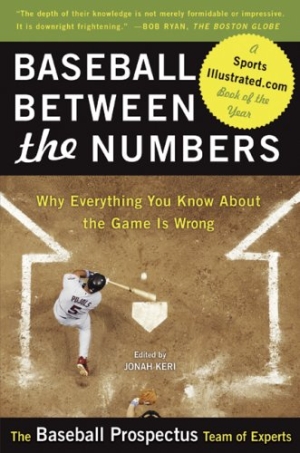Sabermetrics: A Movement In Three Books
Every baseball fan is at the very least aware of increased statistical analysis in Major League Baseball, whether they choose to accept the effectiveness of its application or not. While some fans have stuck with their traditional statistics, others have embraced every “made-up” stat under the sun. And then there are some that are interested, but have never had the inclination to probe the world of WAR, OBP, WPA, VORP, and UZR. If you have no idea what any of those stand for, or you just want to have a better understanding of the movement behind such creations, I present to you the following three books:
 Moneyball: The Art of Winning an Unfair Game
Moneyball: The Art of Winning an Unfair Game
This is the book that alerted regular fans to the idea of sabermetrics. Joe Morgan famously railed against it; nerds in their basements embraced it; Hollywood decided to make a movie out of it. This is not a stat-filled textbook, but a well-written, entertaining story about the Oakland Athletics of the late 90s and early 00s, featuring Billy Beane as the protagonist.
It starts off telling the tale of a can’t-miss prospect who ended up flaming out in the minors even though he possessed all the tools baseball scouts dream of — a cannon for an arm, a beautiful swing, blinding speed, and the body of a Greek god (he even dated all the prettiest girls in high school!). As a prep prospect, he was even more highly touted than Darryl Strawberry. The name of this player was Billy Beane. Yes, the guy that made it cool to look at stats in your mother’s basement was also the prototypical high school alpha male.
Beane wasn’t just a tremendous athlete; he was also an extremely bright kid, but one who didn’t quite put as much effort into school as he should have. Yet he still almost went to college instead of taking the money to play baseball. He regretted the decision later, but he still managed to work himself up to the top of the A’s organization as their GM. Once there, he decided he would change how things were run.
Moneyball delves into how Beane maximized his resources by selecting college players with great stats instead of high school players with great bodies. It harps on the importance of on-base percentage. It chronicles disagreements between Beane — and his sidekick Paul DePodesta with laptop in tow — and his scouts. It’s about a front office trying its best to discover inefficiencies in the market for baseball players, not about glorifying Billy Beane or a particular type of unathletic player. And while naysayers like to point at the playoff failures of those A’s teams as proof that it doesn’t work, winning 100 games isn’t an easy feat, and the baseball playoffs are as close to a crapshoot as sports come. Although, the next book in this post does shed some light on why “Moneyball” didn’t lead to a World Series title.
It’s been a few years since I read it, but Amazin’ Avenue has created a book club around it and I’m trying to keep up through online means, since I gave my copy to my cousin a year or so ago (I wonder if he ever read it). I would recommend following their posts if you want to pick up the book anytime soon. It’s where anyone interested in the “stathead” movement should begin their reading.
 Baseball Between the Numbers: Why Everything You Know About the Game is Wrong
Baseball Between the Numbers: Why Everything You Know About the Game is Wrong
This book from Baseball Prospectus is for anyone who wants to look the baseball with a more critical eye. Most of the stats that populate the book are not very popular in the sabersphere nowadays, but the research and reasoning behind each chapter are still as relevant as ever. There’s the idea of a replacement player and how that is important to assessing a player’s true value, a method of comparing the competitiveness of different leagues (including the minors), a takedown of the perceived importance of the RBI, and plenty of other essential knowledge for any intelligent baseball fan.
There’s also a comparison of Barry Bonds and Babe Ruth and a look at how overpaid Alex Rodriguez is. There’s an argument for a return to the four-man rotation, something I’d love to see make a comeback. There’s a dismantling of the notion that managers actually make a significant difference. There’s even a section which slights how much Rickey Henderson’s stolen-base prowess increased his value as a player. Too much good stuff to lay out in this blog post.
My favorite chapter title has to be “Why Doesn’t Billy Beane’s Shit Work in the Playoffs?”, and it’s definitely one of the more enlightening chapters as well. It shows how the prevailing idea that pitching wins championships is actually somewhat true, that a great rotation has a positive correlation with success in the playoffs. For an example, look at how the Giants won the World Series this year. I guess this is where people who hate “Moneyball” would start reading the book.
Baseball Between the Numbers is just a perfect combination of good writing and good analysis. It doesn’t get too heavy with the stats, providing easy-to-understand charts when needed, and focusing more on the seemingly obvious conclusions which are arrived at after looking at the data, rather than the methodology. Yet everything is still explained enough so you know they are not just making things up nor manipulating the data to fit their agenda. It’s probably my favorite book out of the three which comprise this post.
 The Book: Playing the Percentages in Baseball
The Book: Playing the Percentages in Baseball
This is the graduate course in sabermetrics. Do not read this book unless you like — or at the very least, understand — math. There are win expectancy matrices that take up multiple pages. All you have to do is look at Tom Tango’s website for The Book to realize that this is just pure analysis with little regard for enjoyable writing. The Book has, in addition to the usual Table of Contents, a list of the 140 tables in the textbook. That’s what The Book is — a textbook for managing a baseball game. The preface even says this is an attempt to rewrite “the [unwritten] book”.
The Book delves into platooning, the use of starters and relievers, pinch-hitting, sacrifice bunting, stealing bases, the intentional walk, lineup construction, and pretty much anything else that can be quantified. The authors use empirical data from multiple major league seasons to create their probability matrices and averages. If a math-averse person wanted to, they could just read the little boxes at the end of each section to see what “The Book” says on a specific topic without reading the details. An example would be:
Your three best hitters should bat somewhere in the #1, #2, and #4 slots. Your fourth- and fifth-best hitters should occupy the #3 and #5 slots. The #1 and #2 slots will have players with more walks than those in the #4 and #5 slots. From slot #6 through #9 put players in descending order of quality.
This flies in the face of the accepted wisdom of batting your best “overall” hitter 3rd, a fact which was gospel to me growing up.
As I said earlier, the stats mentioned in Baseball Between the Numbers aren’t exactly the darlings of the sabermetrics fan revolution nowadays. While the second book in this list talks about VORP (Value Over Replacement Player) and WARP (Wins Above Replacement Player), The Book uses WAR (Wins Above Replacement). The Book also goes into the creation and derivation of wOBA (weighted On-Base Average), which is an attempt to quantify each contribution from a hitter as accurately as possible. A stat like OPS (On-base Plus Slugging) weighs OBP (On-Base Percentage) and SLG (Slugging) equally, when OBP is about twice as important.
You must be getting the sense that this book is filled with acronyms and numbers and math. Not that Baseball Between the Numbers doesn’t have its hilarious acronyms, but it’s just not as heavy on the mathematical analysis. Or perhaps I just ignored many of the acronyms in Baseball Between the Numbers since no one uses them, even though the ideas behind them are sound.
The Book also explains the idea of WPA (Win Probability Added), which is tied to the probability matrices I mentioned earlier. Basically, this book is what spawned Fangraphs, which is why this is the book that has the popular acronyms. Baseball Prospectus is just not the sabermetric darling of the moment. While their analysis is better than Fangraphs’, most of it is behind a paywall which even I’ve never paid for (but I’ve been thinking about it lately).
So that’s what a degree in sabermetrics looks like. And once you take it, you won’t be able to stay away from websites like Beyond the Box Score, Fangraphs, Baseball-Reference (well, EVERY baseball fan knows this site), and The Book Blog. In addition to reading The Hardball Times website, you’ll order their Annual each year. Maybe you’ll even love the saber-tinted fantasy analysis at Roto Hardball.
Related posts:














